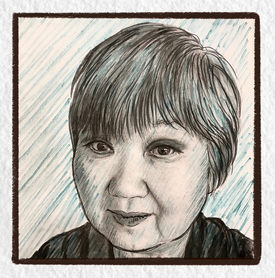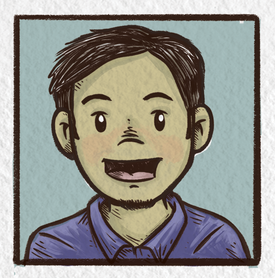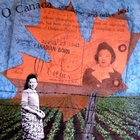Lillian, who is Yukiko? In a nutshell, what is the story of Yukiko?
Lillian: Jeff and I talked a lot about Emma’s Japanese middle name. We decided on Yukiko, Jeff’s young daughter’s name. In the years to come, I think his little girl will be extremely proud of what her father had accomplished in naming the heroine after her.
From your personal experience, how well is the JC story known today in BC? In Ontario?
Lillian: The Japanese Canadian story was relatively unknown in Ontario. The ROM exhibition On Being Japanese Canadian: reflections on a broken world was extremely important. Thousands of people saw it during a six-month period in 2019. It was also the only time that the ROM invited two Japanese Canadian curators to join their own curators – Bryce Kanbara and Dr. Katherine Yamashita. It took a major presentation by Canada’s largest museum to bring to light the injustice perpetrated by the Canadian government against Japanese Canadians.
Jeff: I knew very little about the Japanese Canadian internment until I was in college. It was never really discussed in my family. I learned about the internment of the Japanese Canadians when I made One Big Hapa Family and toured the Nikkei Internment Memorial Centre in New Denver, B.C. for the film in 2008.
At the Nikkei National Museum in Burnaby, BC there are many programs and exhibitions that focus on Japanese Canadian history but there’s very little awareness about this issue in British Columbia outside of the Japanese Canadian community. This is why it was important for us to create On Being Yukiko. We want to help educate people from all backgrounds about the Japanese Canadian internment.
You seem to use “Japanese Canadian” and “Nikkei” interchangeably. Do you see any difference in their meanings?
Jeff: I feel with the history of Japanese Canadians in Canada for over five generations, we are definitely self-identifying more with being Nikkei to keep that connection to Japan. Especially with more mixed children, it’s important to let them know that they can identify as Japanese Canadian and Nikkei. It’s only been more recently that I have been self-identifying as Nikkei.
How did you collaborate? As a fine artist and graphic artist, were there any issues that you had to reconcile? What about the written language of the story?
Lillian: Jeff and I never had issues between us. We listen to each other. We created the book as we went along, not knowing where it would lead us. We did have my grandmother’s story from the past, which was already illustrated, but Jeff had to create an entire script for the present-day experience of Emma and her grandmother. I think that Jeff is the most creative mind I have worked with in a very long time.
Jeff: I knew of Lillian’s work. I had seen her paintings at the Nikkei National Museum. We had mutual respect for each other’s art, which really helped the collaborative process. I really feel that our two styles work very well together because they are such polar opposites.
For my part, I use a style of cartooning that I created 20 years ago which I have coined as ‘Hapanimation’. It’s a blend of Japanese anime and manga with a North American cartoon aesthetic. Lillian’s work is a ‘sketchy realistic’ style. Our stylistic contrast clarifies transitions between the past and present, with my art style representing the present and Lillian’s illustrations representing the past.
I didn’t know the direction the book would take. I knew Lillian’s story about her family but I helped create the present day dialogue, page by page in a sequential order. I drew one page after the next until I reached the end. It’s a risky but magical way of working. I wasn’t even sure how long the book would be when we started. In the end it ended up being 56 pages!
It was a true collaborative process. Because Lillian’s artwork was ready to go, it was fun to lay out her artwork and combine it with mine. Lillian offered a framework for me to expand on. A lot of the ideas grew from her initial script. I would just go in and tweak things or re-write sections of dialogue. It was a strange way of working but in the end, we found a nice flow and appealing aesthetic.
Jeff, what is the value of the “Hapa” discussion in 2020?
Jeff: We set out to create a graphic novel for the Yonsei and Gosei generations. The Nikkei youth who identify as mixed Japanese. In Canada, there’s an almost 100% intermarriage rate within the Japanese Canadian community. We really set out to help the Yonsei and Gosei generations discover a sense of pride for their Japanese roots and history.
Lillian: The mixed-race population in North America is the fastest growing demographic. Mixed- race children need to see more resources in schools which celebrate their identities. Especially in 2020 when diversity and anti-racist education are growing social concerns around the world.
Who do you see as being the audience of this book? What challenges are there in connecting with younger generations?
Jeff: Japanese Canadian community leaders, diverse educators, researchers and most importantly students gave us valuable feedback on initial drafts of the book. It was important for us to have community involvement. We want to make sure that we told this story accurately but most importantly, in a way that it could appeal to kids.
We tell a historical story, but we also tell a story about identity and mixed-race issues for youth. We touch on modern-day anti-racist issues. We don’t go in-depth about these topics but we provide a teachable moment for parents and teachers to answer questions kids may hear in the news.
We also wanted to make a graphic novel that will appeal to all youth regardless of their ethnic backgrounds. In the end, it’s a really compelling story about history, struggle, sacrifice, and identity. We’ve been fortunate from early feedback, that children are reading this with their parents and grandparents. They’ve told us that the book is creating great dialogue and discussion.
Lillian: This book is relevant for young people of all ages, as well as adults. It can initiate discussions about everyone’s journey to Canada and personal experiences of coming to a new country. Children learn through sharing stories that we are all related.
Jeff: We need to keep the dialogue around mixed race identity open in the Nikkei community. I encourage people to check this panel I participated in recently for the Tadaima! A Community Virtual Pilgrimage entitled, Part Japanese, 100% Nikkei. The panel on mixed Japanese identity was joined by other mixed community leaders, artists, and activists - Kip Fulbeck, Megumi Nishikura, Curtiss Takada Rooks, and Ken Tanabe. (You can watch it here)
Lillian: Teachers can use the book as a non-threatening springboard to deliver the Federal anti-racism mandate for schools. It fosters dynamic discussion with students on issues they can only explore in the safe environment of their classroom. Issues of self-identity are rarely discussed at home so that the only place they can discuss difficult issues is through the guidance of teachers.
For each of you, are you as interested in other ethnic aspects of yourselves? What particular value does “Japanese” have for yourselves, your kids, and grandkids going forward?
Lillian: Being of “Japanese” heritage is a huge part of my identity. My daughters and their children identify as “Hapa” and value their Japanese heritage. What I can pass on to them is my family’s story of courage in the face of disaster and their determination to survive with dignity that was beyond their control. Through this book, I think they will learn to face life’s challenges with ‘gaman’.
Jeff: Because of the work I’ve done exploring topics of mixed Japanese and Nikkei identity, I do focus more on the Japanese Canadian part of my life. I’ve become more involved in the JC community and it’s been important for me to introduce my children to it as well. My wife is also part Japanese and as a family, we participate in a lot of Japanese Canadian events including the Powell Street Festival and Nikkei Matsuri at the National Nikkei Museum and Cultural Centre. Her family was interned during WW2 and so now I share that history within my family. It’s important to celebrate the Japanese part of us. Not speaking Japanese makes me feel disconnected when I visit Japan but I love Japanese culture and art, which have greatly influenced my own art.
Jeff, how well informed are British Columbians about the JC experience? What might be the place for the book in BC schools? Across Canada?
Jeff: There is a movement in British Columbia by the National Association of Japanese Canadians to call on the BC government to go beyond just an apology for interning Japanese Canadians during WW2.
There will be more news about the internment in the near future. There are many projects that have come out lately that tackle the internment story: from virtual reality projects, to films, and now this graphic novel. The more JC stories we can tell now and in the future, the wider the audience we can reach in Canada and beyond.
What do you hope will be the place for this book in the wider anti-racism discussion?
Lillian: There has been much injustice against diverse Canadians by our government because of colonialism, white privilege, and unconscious bias. The institutions, justice systems, police, and educational institutions have reinforced dominance over people deemed inferior - Indigenous people, Blacks, people of colour, Jews, white ethnic Europeans, and those who lived in poverty. This book can promote cultural acceptance and justice.
Lillian, knowing what the educational landscape is like in Ontario, what do you hope will be the place for this book in the evolving multicultural literary landscape?
Children must be taught to respect all people, not only people in their own cultural groups. We want an inclusive society where each individual is a valuable part of the whole. Institutions and society at large must recognize their own biases and positions of privilege to change systemic practices which rank the value of people by the colour of their skin, by their religious differences, by their cultural dress, and by their countries of origin.
Any final words? To educators? Parents?
Jeff: We are very proud of this book. It’s a unique intergenerational mash-up, unlike anything that’s ever been done before… an intergenerational Japanese Canadian story told by two intergenerational Japanese Canadian author illustrators.
We knew we were hitting the mark when Joy Kogawa, author of Obasan, read the second draft of On Being Yukiko and provided us a quote for the back cover of the book. She said, “Beautifully told and illustrated. What a gift to Japanese Canadian history.” It’s such an honour to have Joy’s blessing with this book!
* * * * *
Pre-order the hardcover first edition of On Being Yukiko at www.meditatingbunny.com. Pre-orders will be shipped out on the second week of December 2020.
© 2020 Norm Ibuki








